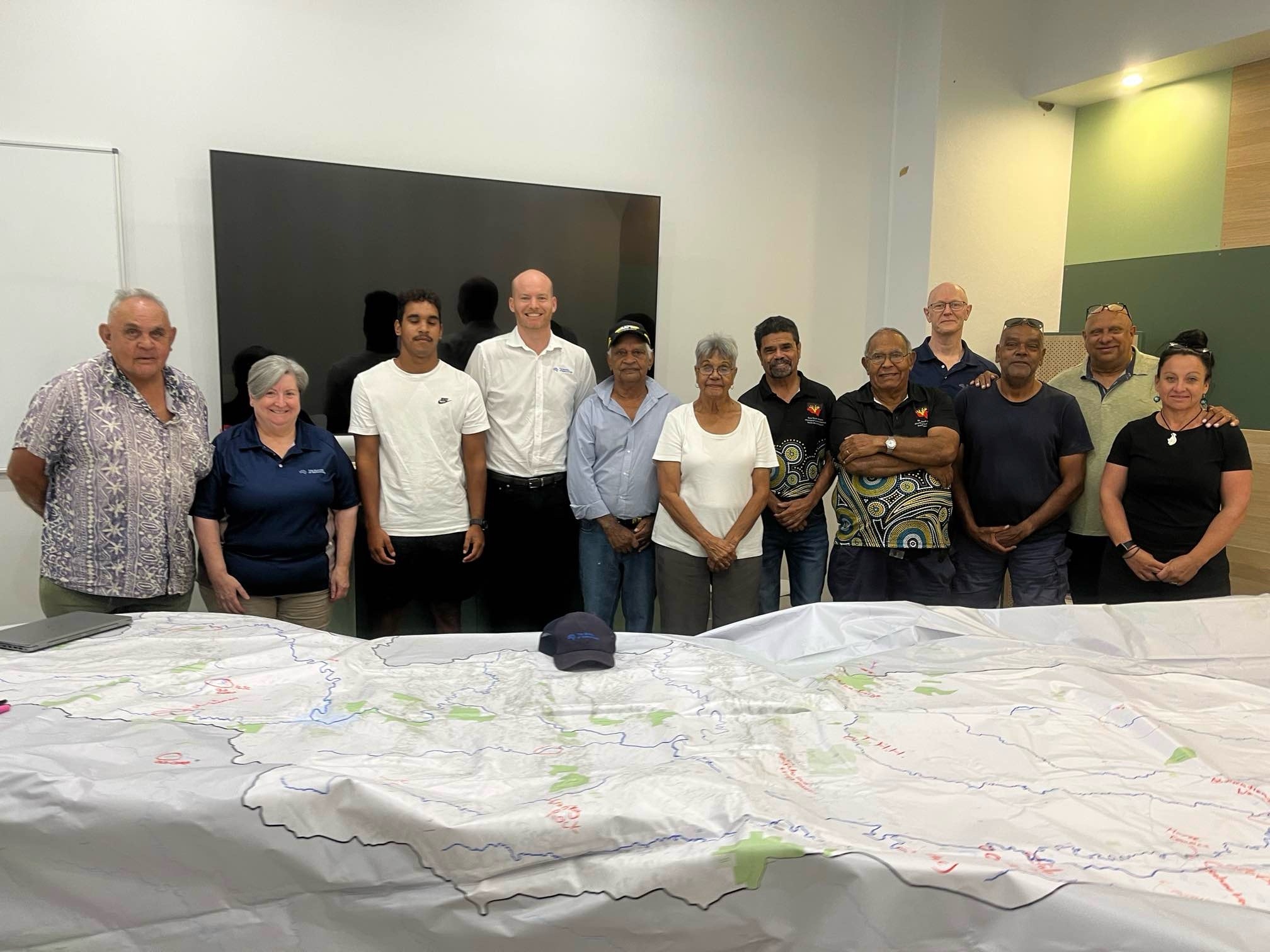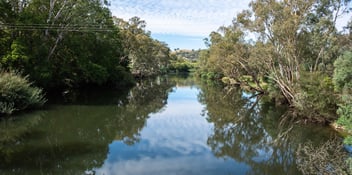Indigenous Knowledge pilot leads on best-practice facilitation

Hosted and guided by Elders and Traditional Owners on Country, a first-of-a-kind Indigenous water information sharing pilot has recently been completed and now forms part of the Murray-Darling Basin Water Information Portal.
The Gwydir Aboriginal Water Information Pilot included workshops and meetings led by proud Gomeroi man, Professor Phil Duncan, University of Canberra Galambany Professorial Fellow, as well as staff from the Bureau of Meteorology, with engagement hosted on Country by Elders over eight months.
“This pilot was an opportunity to integrate Indigenous Knowledges, values and perspectives into a framework that reflected those values in connection to Country, including the cultural responsibilities that we always talk about,” Duncan said.
“It was also an opportunity to continue building the capability of Indigenous people in communities to further understand other aspects of water management and provide access through the portal to information they’d usually have to wait for.”
The information generously shared by Traditional Owners, including stories, recordings and photos from Elders of the Gomeroi and Kamilaroi Nations, now sits alongside other water information for the Gwydir catchment in northern NSW.
Duncan said the pilot also influenced non-Indigenous peers on the project to think about water not just through a mainstream lens, but a cultural lens, as well.
“The relationships that were established through this work were just fantastic and are still in place. The process moved us all very deeply, including myself and my countryman Matt Coulton, as well as the whole team,” he said.
“The meeting room for us was Country. And people’s homes. The Traditional Owners created a safe environment to welcome us. We took their advice; we walked and talked, and were guided by them for the entire journey, sharing the load.”
The Murray-Darling Basin Water Information Portal is a collaboration between the Bureau of Meteorology, the Murray-Darling Basin Authority, Commonwealth Department of Climate Change, Energy, the Environment and Water (DCCEEW) and Basin state agencies.
Elizabeth Johnston from the Agriculture and Water program at the Bureau of Meteorology said the portal provides greater transparency and more timely and efficient access to water information to support water users across the Basin.
"The pilot project was facilitated in 2023 and 2024 when four Bureau of Meteorology staff held four workshops, including in the Gwydir catchment in northern New South Wales, the lands of the Gomeroi/Kamilaroi/Gamilaroi nations, and a meeting, engaging with Traditional Owners as part of the ongoing development of the Murray-Darling Basin Water Information Portal," she said.
“The portal is a central source of water information for the Murray-Darling Basin and provides greater transparency and easier access to Basin-wide information in one easy-to-use portal.”
The final version of the Murray-Darling Basin Water Information Portal, which went live on the Bureau's website on 29 May 2024, now includes First Nations cultural information for the basin for lands of the Gomeroi/Kamilaroi nations as a result of the contributions from the pilot project on the Gwydir.
"The Gwydir Aboriginal Water Information Pilot's key objectives were to align with the Bureau's role as Australia's water information agency, including ensuring we provide water information services that meet the needs of Aboriginal communities and sharing and promoting Indigenous water knowledge, while ensuring that consent and respect for Indigenous Cultural Intellectual Property was paramount," Johnston said.
Setting time aside
Duncan said allowing Traditional Owners to host and facilitate the pilot on their own terms was fundamental to ensuring the information collated was appropriately shared in respect to Country and culture.
“A fundamental part of this wonderful process is that we didn’t come to this work with a time frame. We came with a wandering mind. We allowed the leadership from the Indigenous stakeholders to not just advise us but guide us on what this looks like through their eyes,” he said.
“We were not encumbered by deadlines or a departmental ideology. It was all done from a cultural ideology and a cultural methodology. We didn’t just go to the towns; we were taken out to very special places and conducted interviews where people felt comfortable.”
Leading with respect for cultural protocols is also about allowing those protocols to shape what is created, but also how it is shared, Duncan said.
“One of the first things we did was ask the communities how they needed us to work with them, and what was required to ensure protection of Indigenous Cultural Intellectual Property. We wanted to make sure that that was done in the most culturally appropriate manner,” he said.
“It’s not just about getting consent, it’s about the ongoing protection of culture."
From the Bureau’s perspective, Johnston said the role of the team involved was to take the lead of the Gomeroi and Kamilaroi, but also the importance of building trusted relationships.
"The project team learnt that it is essential that engagement with First Nations builds on ongoing relationships, rather than isolated occasions to seek information. As trust builds, the Elders will share more of their stories,” she said.
"In order to demonstrate trust and a genuine commitment to the Indigenous Cultural Intellectual Property remaining with the First Nations people, the Bureau prepared a letter of consent to make it clear that ownership of cultural information remained with the Elders.
"The letter of consent was developed with experts in Indigenous Cultural Intellectual Property and facilitated by Bureau legal. It was another key element for the Bureau in terms of building trust and providing confidence for Elders to participate."
Two-way learning and benefits
Duncan said that while Traditional Owners shared a lot of crucial information with the Bureau, the process also gave Aboriginal communities the opportunity to learn about western water data and management principles.
“It created greater confidence for Traditional Owners to use IT to build their understanding of water management. But also, working with stories and data, there were some amazing perspectives that came together,” he said.
"There was one Elder who worked out on the watercourse, they said water had been there for hundreds of years, the wetland only changed when Copeton Dam was built in 1972. We were able to capture that in the data.
"We maximised the opportunity to bring IT into a visible way of learning. We had Elders standing between a physical map and a digital map, and they were blown away by the level of information we were able to show them.
“It was one of the most visible, wonderful examples of two‑way knowledge exchange, bringing western science and cultural science together.”
Duncan said a crucial pillar to the success of the pilot was the trust that was created by being willing to listen: “We were having some wonderful conversations between the face-to-face meetings”.
“Such was the way, the community were happy with the way we were engaging with them. It created a distinct capacity for trust. People were ringing up in between meetings,” he said.
Fundamental to the success of the pilot was allowing Traditional Owners to lead the whole process and how the pilot would unfold, Duncan said.
“If people come into this kind of work with time demands, they will fail. Elders leading is the best process. It is transparent, it is accountable, and it is a two-way conversation right throughout,” he said.
"If you want to know how to do business with mob and truly walk and talk with them, the model utilised here is what you’ve got to follow.”


